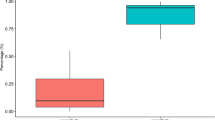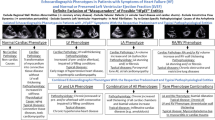Abstract
Left ventricular hypertrophy (LVH) is a common finding on pediatric electrocardiography (ECG) leading to many referrals for echocardiography (echo). This study utilizes a novel analytics tool that combines ECG and echo databases to evaluate ECG as a screening tool for LVH. SQL Server 2012 data warehouse incorporated ECG and echo databases for all patients from a single institution from 2006 to 2016. Customized queries identified patients 0–18 years old with LVH on ECG and an echo performed within 24 h. Using data visualization (Tableau) and analytic (Stata 14) software, ECG and echo findings were compared. Of 437,699 encounters, 4637 met inclusion criteria. ECG had high sensitivity (≥ 90%) but poor specificity (43%), and low positive predictive value (< 20%) for echo abnormalities. ECG performed only 11–22% better than chance (AROC = 0.50). 83% of subjects with LVH on ECG had normal left ventricle (LV) structure and size on echo. African-Americans with LVH were least likely to have an abnormal echo. There was a low correlation between V6R on ECG and echo-derived Z score of left ventricle diastolic diameter (r = 0.14) and LV mass index (r = 0.24). The data analytics client was able to mine a database of ECG and echo reports, comparing LVH by ECG and LV measurements and qualitative findings by echo, identifying an abnormal LV by echo in only 17% of cases with LVH on ECG. This novel tool is useful for rapid data mining for both clinical and research endeavors.






Similar content being viewed by others
References
Harmon KG, Zigman M, Drezner JA (2015) The effectiveness of screening history, physical exam, and ECG to detect potentially lethal cardiac disorders in athletes: a systematic review/meta-analysis. J Electrocardiol 48(3):329–338
Myerburg RJ, Vetter VL (2007) Electrocardiograms should be included in preparticipation screening of athletes. Circulation 116:2616–2626
Myerburg RJ, Kessler KM, Castellanos A (1993) Sudden cardiac death: epidemiology, transient risk, and intervention assessment. Ann Intern Med 119:1187–1197
Corrado D, Pelliccia A, Bjornstad HH, Vanhees L, Biffi A, Borjesson M et al (2005) Cardiovascular pre-participation screening of young competitive athletes for prevention of sudden death: proposal for a common European protocol: consensus statement of the Study Group of Sport Cardiology of the Working Group of Cardiac Rehabilitation and Exercise Physiology and the Working Group of Myocardial and Pericardial Diseases of the European Society of Cardiology. Eur Heart J 26:516–524
Fuller CM (2000) Cost effectiveness analysis of screening of high school athletes for risk of sudden cardiac death. Med Sci Sports Exerc 32:887–890
Wheeler MT, Heindenreich PA, Froelicher VF, Hlatky MA, Ashley EA (2010) Cost-effectiveness of preparticipation screening for prevention of sudden cardiac death in young athlets. Ann Intern Med 152:276–286
Maron BJ, Thompson PD, Ackerman MJ, Balady G, Berger S, Cohen D et al (2007) Recommendations and considerations related to preparticipation screening for cardiovascular abnormalities in competitive athletes: 2007 update: a scientific statement from the American Heart Association Council on Nutrition, Physical Activity, and Metabolism: endorsed by the American College of Cardiology Foundation. Circulation 115:1643–1655
Fuller CM, McNulty CM, Spring DA, Arger KM, Bruce SS, Chryssos BE et al (1997) Prospective screening of 5,615 high school athletes for risk of sudden cardiac death. Med Sci Sports Exerc 29:1131–1138
Drezner JA, Owens DS, Prutkin JM, Salerno JC, Harmon KG, Prosise S et al (2016) Electrocardiographic screening in National Collegiate Athletic Association Athletes. Am J Cardiol 118:754–759
Devereux RB, Casale PN, Eisenberg RR, Miller DH, Kligfield P (1984) Electrocardiographic detection of left ventricular hypertrophy using echocardiographic determinants of left ventricular mass as the reference standard. J Am Coll Cardiol 3:82–87
Levy D, Labib SB, Anderson KM, Christiansen JC, Kannel WB, Castelli WP (1990) Determinants of sensitivity and specificity of electrocardiographic criteria for left ventricular hypertrophy. Circulation 81:815–820
Rivenes SM, Colan SD, Easley KA, Kaplan S, Jenkins KJ, Khan MN et al (2003) Usefulness of the pediatric electrocardiogram in detecting left ventricular hypertrophy: results from the prospective pediatric pulmonary and cardiovascular complications of vertically transmitted HIV infection (P2C2 HIV) multicenter study. Am Heart J 145:716–723
Drezner JA, Acherman MJ, Anderson J, Ashley E, Asplund CA, Baggish AL et al (2013) Electrocardiographic interpretation in athletes: the ‘Seattle Crteria’. Br J Sports Med 47:122–124
Sheikh N, Papadakis M, Ghani S, Aaidi A, Gati S, Adami PE et al (2014) Comparison of electrocardiographic criteria for the detection of cardiac abnormalities in elite black and white athletes. Circulation 129:1637–1649
Czosek RJ, Cnota JF, Knilans TK, Pratt J, Guerrier K, Anderson JB (2014) Relationship between echocardiographic LV mass and ECG based left ventricular voltages in an adolescent population: related or random? PACE 37:1133–1140
Jingi AM, Noubiap JJN, Kamdem P, Kingue S (2014) Determinants and improvement of electrocardiographic diagnosis of left ventricular hypertrophy in a black African population. PLoS ONE 9(5):e96783
Bratincsák A, Williams M, Kimata C, Perry JC (2015) The electrocardiogram is a poor diagnostic tool to detect left ventricular hypertrophy in children: a comparison with echocardiographic assessment of left ventricular mass. Congenit Heart Dis 10(4):E164–E171
Di Diola G, Creta A, Campanale CM, Fittipaldi M, Giorgino R, Quintarelli F et al (2016) ECG is an inefficient screening-tool for left ventricular hypertrophy in normotensive African children population. PeerJ 4:e2439
Lang RM, Badano LP, Mor-Avi V, Afilalo J, Armstrong A, Ernande L et al (2005) Recommendations for chamber quantification by echocardiography in adults: an update from the American Society of Echocardiography and the European Association of Cardiovascular Imaging. J Am Soc Echocardiogr 18:1454–1457
StataCorp. (2015) Stata statistical software: release 14. College Station, TX: StataCorp LP
Okin PM, Roman MJ, Devereux RB, Klingflield P (1995) Gender differences and the electrocardiogram in left ventricular hypertrophy. Hypertension 25(2):242–249
Pelletier JH, Blanchard S, Chamberlain RC, Hornik CP, Campbell MJ, Hill KD (2017) The use of echocardiography for pediatric patients presenting with syncope. J Pediatr 190:43–48
Steinberg LA, Knilans TK (2005) Syncope in children: diagnostic tests have a high cost and low yield. J Pediatr 146(3):355–358
Lang RM (2010) Preauthorization, precertification and prenotification imposed by private insurance carriers: a big step in the wrong direction for patient care. J Am Soc Echocardiogr 23(1):35A–36A
Lou S, Nielsen CP, Hvidman L, Petersen OB, Risor MB (2016) Coping with worry while waiting for diagnostic results: a qualitative study of the experiences of pregnant couples following a high-risk prenatal screening result. BMC Pregnancy Childbirth 16:321
Portnoy DB (2010) Waiting is the hardest part: anticipating medical test results affects processing and recall of important information. Soc Sci Med 71:421–428
Hancock EW, Deal BJ, Mirvis DM, Okin P, Kligfield P, Gettes LS (2009) AHA/ACCF/HRS recommendations for the standardization and interpretation of the electrocardiogram part V: electrocardiogram changes associated with cardiac chamber hypertrophy a scientific statement from the American Heart Association Electrocardiography and Arrhythmias Committee, Council on Clinical Cardiology; the American College of Cardiology Foundation; and the Heart Rhythm Society. Circulation 119:e251–e261
Sokolow M, Lyon TP (1949) The ventricular complex in left ventricular hypertrophy as obtained by unipolar and limb leads. Am Heart J 37:161–186
Casale P, Devereux R, Kligfield P, Eisenberg RR, Miller DH, Chaudhary BS et al (1985) Electrocardiographic detection of left ventricular hypertrophy: development and prospective validation of improved criteria. J Am Coll Cardiol 6:572–580
Takase H, Sugiura T, Murai S, Yamashita S, Ohte N, Dohi Y (2016) Use of electrocardiography to predict future development of hypertension in the general population. Medicine (Baltimore) 95(17):e3483
Muiesan ML, Salvetti M, Di Castelnuovo A, Paini A, Assanelli D, Costanzo S et al (2017) Obesity and ECG left ventricular hypertrophy. J Hypertens 35(1):162–169
Rider OJ, Ntusi N, Bull SC, Nethononda R, Ferreira V, Holloway CJ et al (2016) Improvements in ECG accuracy for diagnosis of left ventricular hypertrophy in obesity. Heart 102(19):1566–1572
Sheikh N, Papadakis M, Carre F, Kervio G, Panoulas VF, Ghani S et al (2013) Cardiac adaptation to exercise in adolescent athletes of African ethnicity: an emergent elite athletic population. Br J Sports Med 47(9):585–592
Author information
Authors and Affiliations
Corresponding author
Ethics declarations
Conflict of interest
A collaborator contractual agreement has been completed and signed between Philips Healthcare, a division of Philips Electronics North America Corporation, and Children’s National Health System, division of cardiology. There exist no financial interests for the investigator or provider institutions in the outcome of the research.
Research Involving Human and Animal Participants
This article does not contain any studies with human participants or animals performed by any of the authors.
Rights and permissions
About this article
Cite this article
Tague, L., Wiggs, J., Li, Q. et al. Comparison of Left Ventricular Hypertrophy by Electrocardiography and Echocardiography in Children Using Analytics Tool. Pediatr Cardiol 39, 1378–1388 (2018). https://doi.org/10.1007/s00246-018-1907-7
Received:
Accepted:
Published:
Issue Date:
DOI: https://doi.org/10.1007/s00246-018-1907-7




